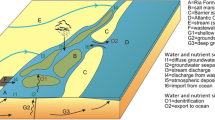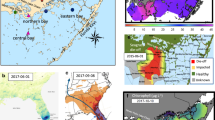Abstract
The marine shelf areas in subtropical and tropical regions represent only 35% of the total shelf areas globally, but receive a disproportionately large amount of water (65%) and sediment (58%) discharges that enter such environments. Small rivers and/or streams that drain the mountainous areas in these climatic zones deliver the majority of the sediment and nutrient inputs to these narrow shelf environments; such inputs often occur as discrete, episodic introductions associated with storm events. To gain insight into the linked biogeochemical behavior of subtropical/tropical mountainous watershed-coastal ocean ecosystems, this work describes the use of a buoy system to monitor autonomously water quality responses to land-derived nutrient inputs and physical forcing associated with local storm events in the coastal ocean of southern Kaneohe Bay, Oahu, Hawaii, USA. The data represent 2.5 years of near-real time observations at a fixed station, collected concurrently with spatially distributed synoptic sampling over larger sections of Kaneohe Bay. Storm events cause most of the fluvial nutrient, particulate, and dissolved organic carbon inputs to Kaneohe Bay. Nutrient loadings from direct rainfall and/or terrestrial runoff produce an immediate increase in the N:P ratio of bay waters up to values of 48 and drive phytoplankton biomass growth. Rapid uptake of such nutrient subsidies by phytoplankton causes rapid declines of N levels, return to N-limited conditions, and subsequent decline of phytoplankton biomass over timescales ranging from a few days to several weeks, depending on conditions and proximity to the sources of runoff. The enhanced productivity may promote the drawing down of pCO2 and lowering of surface water column carbonate saturation states, and in some events, a temporary shift from N to P limitation. The productivity-driven CO2 drawdown may temporarily lead to air-to-sea transfer of atmospheric CO2 in a system that is on an annual basis a source of CO2 to the atmosphere due to calcification and perhaps heterotrophy. Storms may also strongly affect proximal coastal zone pCO2 and hence carbonate saturation state due to river runoff flushing out high pCO2 soil and ground waters. Mixing of the CO2-charged water with seawater causes a salting out effect that releases CO2 to the atmosphere. Many subtropical and tropical systems throughout the Pacific region are similar to Kaneohe Bay, and our work provides an important indication of the variability and range of CO2 dynamics that are likely to exist elsewhere. Such variability must be taken into account in any analysis of the direction and magnitude of the air–sea CO2 exchange for the integrated coastal ocean, proximal and distal. It cannot be overemphasized that this research illustrates several examples of how high frequency sampling by a moored autonomous system can provide details about ecosystem responses to stochastic atmospheric forcing that are commonly missed by traditional synoptic observational approaches. Finally, the work exemplifies the utility of combining synoptic sampling and real-time autonomous observations to elucidate the biogeochemical and physical responses of coastal subtropical/tropical coral reef ecosystems to climatic perturbations.










Similar content being viewed by others
References
Atkinson MJ (2000) Kanoehe Bay. In: Talbot F, Wilkinson C (eds) Coral reefs, mangroves and seagrasses: a sourcebook for managers. Science Communications AIMS
Bathen K (1968) A descriptive study of the physical oceanography of Kane’ohe Bay, O’ahu, Hawaii. Department of Oceanography. Honolulu, University of Hawaii at Manoa
Billen G, Garnier J, Ficht A, Cun C (2001) Modeling the response of water quality in the Seine River Estuary to human activity in its watershed over the last 50 years. Estuaries 24:977–993
Cox DC, Fan PF, Chave KE et al (1973) Estuarine pollution in the State of Hawaii; Kaneohe Bay study. University of Hawaii Water Resources Research Center
D’Elia CF, Boynton WR, Sanders JG (2003) A watershed perspective on nutrient enrichment, science, and policy in the Patuxent River, Maryland: 1960–2000. Estuaries 26:171–185
De Carlo EH, Dollar SJ (1997) Assessment of suspended solids and particulate nutrient loading to surface runoff and the coastal ocean in the Honokowai Drainage Basin, Lahaina District, Maui. Final report to NOAA/Algal Blooms Project and Hawaii State DOH. p 32
De Carlo EH, Hoover DJ, Young CW, Hoover RS, Mackenzie FT (2007) Impact of storm runoff from subtropical watersheds on coastal water quality and productivity. Appl Geochem 22:1777–1797. http://dx.doi.org/10.1016/j.apgeochem.2007.03.034
Fagan KE, Mackenzie FT (2007) Air-sea CO2 exchange in a subtropical estuarine-coral reef system, Kaneohe Bay, Oahu, Hawaii. Mar Chem 106:174–191
Falter JL, Atkinson MJ, Merrifield MA (2004) Mass-transfer limitation of nutrient uptake by a wave-dominated reef flat community. Limnol Oceanogr 49:1820–1831
Fisher TR, Harding LW Jr, Stanley DW, Ward LG (1988) Phytoplankton, nutrients, and turbidity in the Chesapeake, Delaware, and Hudson estuaries. Estuar Coast Shelf Sci 27:61–93
Giambelluca TW, Nullet MA, Schroeder TA (1986) Rainfall Atlas of Hawaii. Department of Land and Natural Resources, State of Hawaii
Hearn C, Atkinson MJ (2000) Effects of sea-level rise on the hydrodynamics of a coral reef lagoon: Kaneohe Bay, Hawaii. In: Noye J (ed) Sea-level changes and their effects. World Scientific Publishing Co. Pte. Ltd, Singapore, pp 25–48
Hollet KJ (1977) Shoaling of Kaneohe Bay, Oahu, Hawaii in the period 1927–1976, based on bathymetric, sedimentological, and geographical studies. M.S. Thesis, University of Hawaii, Honolulu, Hawaii, p 145
Hoover DJ (2002) Fluvial nitrogen and phosphorus inputs to Hawaiian coastal waters: storm loading, particle-solution transformations and ecosystem impacts. Department of Oceanography. Honolulu, University of Hawaii
Hoover D, Mackenzie FT (2009) Fluvial fluxes of water, suspended particulate matter, and nutrients and potential impacts on tropical coastal water biogeochemistry: Oahu, Hawaii. Aquat Geochem 15(4):547–570
Hoover RS, Hoover D, Miller M, Landry MR, De Carlo EH, Mackenzie FT (2006) Zooplankton response to storm runoff in a tropical estuary: bottom up and top down controls. Mar Ecol Prog Ser 318:187–201
Hubertz ED, Cahoon LB (1999) Short-term variability of water quality parameters in two shallow estuaries of North Carolina. Estuaries 22:814–823
Hunter CL, Evans CW (1995) Coral reefs in Kaneohe Bay, Hawaii: two centuries of western influence and two decades of data. Bull Mar Sci 57:501–515
Jokiel PL, Hunter CL, Taguchi S, Watarai L (1993) Ecological impact of a fres water “reef kill” on the reefs of Kaneohe Bay, Oahu, Hawaii. Coral Reefs 12:177–184
Jordan EE, Correll DL, Miklas J, Weller DE (1991) Nutrients and chlorophyll at the interface of a watershed and an estuary. Limnol Oceanogr 36:251–267
Keeling RF, Piper SC et al. (2007) Atmospheric carbon dioxide record from Cape Kumukahi, Hawaii. from http://cdiac.ornl.gov/trends/co2/sio-kum.html
Kinzie III RA, Mackenzie FT, Smith SV, Stimson J (2001) CISNet: linkages between a tropical watershed and reef ecosystem. Final project report to NOAA. University of Hawaii, Honolulu
Laws EA, Allen CB (1996) Water quality in a subtropical embayment more than a decade after diversion of sewage discharges. Pac Sci 50(2):194–210
Ostrander CE, McManus MA, DeCarlo EH, Mackenzie FT (2008) Temporal and spatial variability of freshwater plumes in a semi-enclosed estuarine-bay system. Estuaries Coasts 31:192–203. http://dx.doi.org/10.1007/s12237-007-9001-z
Parsons TR, Maita Y, Lalli CM (1984) A manual of chemical and biological methods for seawater analysis. Pergamon Press, New York
Rabalais N (2004) Eutrophication. In: Robinson AR, McCarthy J, Rothschild BJ (eds) The global coastal ocean: multiscale interdisciplinary processes, the sea, vol 13, Chapter 21. Harvard University Press, Cambridge, pp 819–865
Rabalais NN, Atilla N, Normandeau C, Turner RE (2004) Ecosystem history of Mississippi River-influenced continental shelf revealed through preserved phytoplankton pigments. Mar Pollut Bull 49:537–547
Ringuet S, Mackenzie FT (2005) Controls on nutrient and phytoplankton dynamics during normal flow and storm runoff conditions, Southern Kaneohe Bay, Hawaii. Estuaries 28(3):327–337
Roy KJ (1970) Change in bathymetric configuration, Kaneohe Bay, Oahu, 1882–1969. University of Hawaii, HIG Report 70-15, p 26
Scavia D, Rabalais NN, Turner RE, Justic D, Wiseman WJ Jr (2003) Predicting the response of Gulf of Mexico hypoxia to variations in Mississippi River nitrogen load. Limnol Oceanogr 48:951–956
Shamberger KEF, Richard Feely RA, Sabine CL, Drupp P, De Carlo EH, Mackenzie FT, Atkinson MJ, Butterfield DA (2010) Ocean acidification and calcification on a Hawaiian coral reef, ocean sciences meeting, 22–26 Feb 2010, Portland, Oregon. Paper BO15-11
Smith SV, Kimmerer WJ, Laws EA, Brock RE, Walsh TW (1981) Kane’ohe Bay sewage diversion experiment: perspective on ecosystem responses to nutritional perturbation. Pac Sci 35(4):279–395
Solomon RF, De Carlo EH, Drupp PS, Mackenzie FT, MacManus MA, Maenner-Jones S, Shamberger KE, Sabine CL, Feely RA. The role of local climatic variability in the exchange of CO2 between the ocean and atmosphere in a tropical coral reef environment. Mar Chem (in press)
Strickland JDH, Parsons TR (1972) A practical handbook of seawater analysis, 2nd edn. Fisheries Research Board of Canada, Ottawa
Taguchi S, Laws EA (1987) Patterns and causes of temporal variability in the physiological condition of the phytoplankton community in Kaneohe Bay, Hawaii. J Plankton Res 9:1143–1157
Taguchi S, Laws EA (1989) Biomass and compositional characteristics of Kaneohe Bay, Oahu, Hawaii, phytoplankton inferred from regression analysis. Pac Sci 43(4):316–331
Takahashi T, Olafsson J, Goddard J, Chapman DW, Sutherland SC (1993) Seasonal variation of CO2 and nutrients in the high-latitude surface oceans: a comparative study. Glob Biogeochem Cycles 7:843–878
Takahashi T, Sutherland SC, Sweeney C, Poisson A, Metzl M, Tilbrook B, Bates N, Wanninkhof R, Feely RA, Sabine C, Olafsson J, Nojiri Y (2002) Global sea–air CO2 flux basedon climatological surface ocean pCO2, and seasonal biological and temperature effects. Deep-Sea Res II 49:1601–1622
Tanaka K, Mackenzie FT (2005) Statistical and stability analysis of subtropical ecosystem dynamics in souther Kaneohe Bay. Hawaii Ecol Model 188:296–326
Tomlinson MS, De Carlo EH (2003) The need for high resolution time series data to characterize Hawaiian streams. J Am Water Resour Assoc 39:113–123
Turner RE, Rabalais NN (2004) Suspended sediment, C, N, P, and Si yields from the Mississippi River Basin. Hydrobiologia 511:79–89
Acknowledgments
The authors would like to express their appreciation for the logistical support provided by the Hawaii Institute of Marine Biology (HIMB), especially Dr. Jo Ann Leong, director of HIMB, and her staff including Jim Lakey, Fritz King, Wayne Nakamoto, Jimmy Olson, and Darren Oshiro. Much of our work in Kaneohe Bay would also not have been possible without the continued cooperation and assistance of NOAA/PMEL engineering and technical personnel, in particular Noah Lawrence-Slavas, Stacy Maenner-Jones, Christian Meinig, and Sylvia Musielewicz. We are also grateful for constructive comments provided by Stephen V. Smith and two anonymous reviewers; their contributions helped substantially improve this manuscript.
This work was supported in part by a grant/cooperative agreement from the National Oceanic and Atmospheric Administration, Project R/EL-33, which is sponsored by the University of Hawaii Sea Grant College Program, SOEST, under Institutional Grant No. NA05OAR4171048 from NOAA Office of Sea Grant, Department of Commerce. The views expressed herein are those of the author(s) and do not necessarily reflect the views of NOAA or any of its subagencies, and through NSF grant OCE0749404 to Fred T. Mackenzie and Abraham Lerman. This is UNIHI-SEAGRANT-JC-05-43 and SOEST contribution number 7950.
Author information
Authors and Affiliations
Corresponding author
Rights and permissions
About this article
Cite this article
Drupp, P., De Carlo, E.H., Mackenzie, F.T. et al. Nutrient Inputs, Phytoplankton Response, and CO2 Variations in a Semi-Enclosed Subtropical Embayment, Kaneohe Bay, Hawaii. Aquat Geochem 17, 473–498 (2011). https://doi.org/10.1007/s10498-010-9115-y
Received:
Accepted:
Published:
Issue Date:
DOI: https://doi.org/10.1007/s10498-010-9115-y




